Note from Mr. W: 3/27/22.
This page is still under construction as I adapt it for HS use. In the meanwhile, please go ahead and use the AP Bio/College Bio version of this tutorial.
1. Adaptations are traits that help organisms to survive and/or reproduce

Consider this leaf insect. It’s part of a family of insects called Phylliidae. All of the species within this family are leaf mimics: they’re camouflaged to look like leaves.
Camouflage is an adaptation. An adaptation is trait that helps an organism to survive and/or reproduce. Because of their camouflage, leaf Insects less likely to be noticed and eaten by a predator. In other words, looking like a leaf helps a leaf mimic to survive and pass its genes on.
A related adaptation involves how these insects walk. They rock back and forth, making them look like leaves being blown by the wind.
Among living things, adaptations are everywhere. Here are a few more examples:
- The ability of bats to hunt their insect prey through echolocation: With their extremely high-pitched voices, bats call out into their environment. Then they listen to the echoes that bounce back. Based on the pattern of echoes, a bat can hone in on an insect flying through the air. Dolphins use a similar system to hunt their prey.
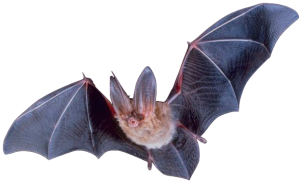
A bat’s ears are an adaptation for hunting prey by echolocation. - The height of a redwood tree, which can grow up to 100 meters tall (300 feet) in order to reach the sunlight which powers photosynthesis.
- Snake venom. Most venomous snakes use specialized fangs to inject their venom into their prey. Once injected, the venom causes paralysis and/or massive tissue damage.
- The ability of a kestrel (a small hawk) to see ultraviolet light. This allows the kestrel to see the glowing traces of urine left on rocks and soil by mice and other rodents. Based on these traces, kestrels identify areas where they can successfully hunt for their prey.
- The camouflage of the satanic leaf gecko of Madagascar: another leaf mimic.
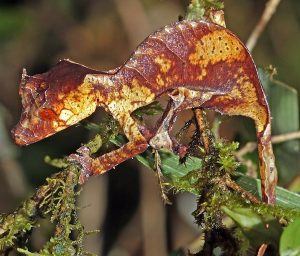
The satanic leaf gecko of Madagascar (click to view a larger image). - The toxic skin of the poison dart frog of central and South America. This toxicity makes these animals extremely unpalatable to predators. To advertise their toxicity, these frogs have evolved a corresponding adaptation: warning coloration. As opposed to camouflaging themselves, they advertise themselves with coloration that signals “Don’t bother eating me: I taste terrible.”
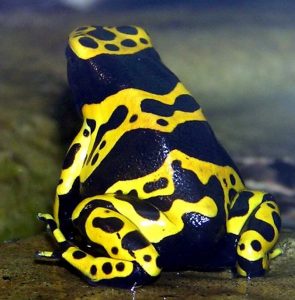
Yellow-banded poison dart frog (Dendrobates leucomelas). Click to view a larger version image).
Adaptations are always linked to a specific environmental context. Leaf mimicry, whether it’s in an insect or a gecko, only works as a camouflage adaptation in a leafy forest. In another environment — a treeless desert, or a forest where the leaves have fallen off the trees — looking like leaf becomes a liability. In a non-leafy environment, leaf mimicry would make survival less likely.
Adaptations are the result of a process called natural selection. To see how natural selection works, we’ll start by looking at how humans have been able to create desired traits in domesticated plants and animals.
2. Adaptations: Flashcards
[qdeck]
[h]Adaptations Flashcards
[q]What are adaptations?
[a]Adaptations are traits that help organisms to survive and/or reproduce.
[q]List a few examples of adaptations that you learned about in the reading above.
[a]From the list above, you should have been able to list
- camouflage
- echolocation
- the toxic skin of the poison dart frog, and its warning coloration.
[q]What does it mean to say that “adaptations are always linked to a specific environmental context?”
[a]It means that a feature (like a specific type of camouflage) that’s adaptive in one environment might not be adaptive in another environment.
[q]What’s the name for the process that produces adaptations?
[a]Adaptations arise through natural selection.
[/qdeck]
3. Selective breeding, or artificial selection, parallels how adaptations arise in nature
Let’s start by answering two questions about some organisms that we’re familiar with. All of these questions are going to be related to the idea of a species: a group of organisms that can interbreed with one another to produce fertile offspring.
[qwiz]
[h]How Many Species?
[q multiple_choice=”true”] How many species are shown below?
[c]ID E=[Qq]
[f]IFRoYXQmIzgyMTc7cyBjb3JyZWN0LiBBbGwgb2YgdGhlc2UgcGxhbnRzIGFyZSB2YXJpZXRpZXMgb2YgdGhlIHNhbWUgc3BlY2llcywgQnJhc3NpY2Egb2xlcmFjZWEswqA=b3Igd2lsZCBjYWJiYWdlLiBUaGUgd2lsZCBmb3JtIGxvb2tzIGxpa2UgdGhpczo=
Cg==[c]IDQ=[Qq]
[f]IE5vLiBBbGwgb2YgdGhlc2UgcGxhbnRzIGFyZSB2YXJpZXRpZXMgb2YgdGhlIHNhbWUgc3BlY2llcywgQnJhc3NpY2Egb2xlcmFjZWEswqA=b3Igd2lsZCBjYWJiYWdlLiBUaGUgd2lsZCBmb3JtIGxvb2tzIGxpa2UgdGhpczo=
Cg==[q multiple_choice=”true”] How many species are shown below?
[c]ID E=[Qq]
[f]IFRoYXQmIzgyMTc7cyBjb3JyZWN0LiBBbGwgb2YgdGhlc2UgZG9ncyBhcmUgdmFyaWV0aWVzIG9mIHRoZSBzYW1lIHNwZWNpZXMsIA==Q2FuaXMgbHVwdXMsIA==b3Igd29sdmVzLiBUaGUgd2lsZCBmb3JtIGxvb2tzIGxpa2UgdGhpczo=
Cg==[c]IDM=[Qq]
[f]IE5vLiBBbGwgb2YgdGhlc2UgZG9ncyBhcmUgdmFyaWV0aWVzIG9mIHRoZSBzYW1lIHNwZWNpZXMsIA==Q2FuaXMgbHVwdXMsIA==b3Igd29sdmVzLiBUaGUgd2lsZCBmb3JtIGxvb2tzIGxpa2UgdGhpczo=
Cg==[/qwiz]
What you saw above are both the results of selective breeding. In selective breeding, animal or plant breeders think of a desired trait in an animal or a plant. For many generations, breeders select organisms with that desired trait. That means that the breeders allow only those individuals with the desired trait to reproduce. The breeders, in other words, create and maintain a carefully guarded gene pool that only includes individuals with genes for the desired trait.
In the case of plants, breeders select seeds from those plants with the desired trait, and use those seeds for the next crop. The many varieties of the wild cabbage, Brassica oleracea, are an example.
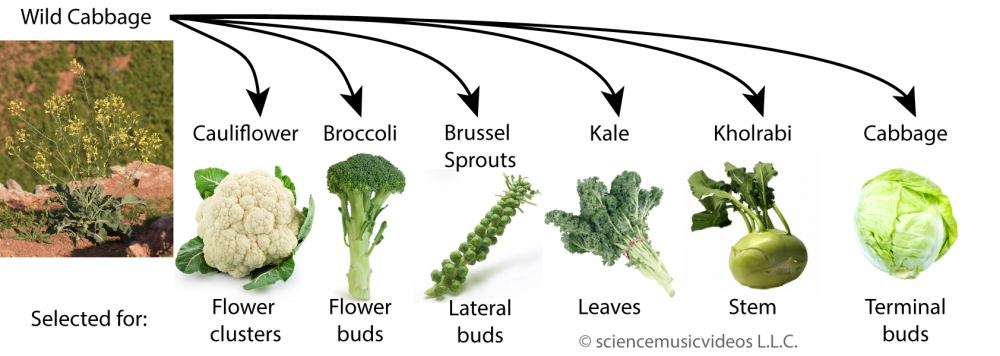
Here’s how breeders took wild cabbage, and through artificial selection, created all of the varieties shown above.
- Selection the clusters at the base of the flower led to cauliflower.
- Selection for flower buds and stems led to broccoli
- Selection for lateral buds led to Brussel sprouts
- Selection for leaves led to kale.
- Selection for a thick stem led to kohlrabi.
- Selection for terminal leaf buds led to cabbage.

Note that any of these varieties can be interbred with one another. That’s because they’re all members of the same species. For example, breeding cauliflower with broccoli creates broccoflower (also known as broccoli Romanesco).
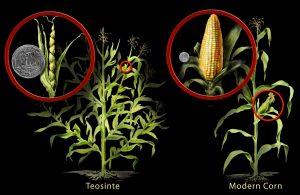
Almost all of the plants we eat came to have their current form through selective breeding or artificial selection. To focus on just one, maize or corn was first domesticated about 10,000 years ago by people living in Mexico. To domesticate means to take a wild species and to breed it so that it becomes suited to human purposes.
The wild ancestor of maize is a plant called teosinte. Teosinte is a wild grass, highly branched, with small seeds and cobs. The ancient Mexicans who bred teosinte into its modern form selected two traits: 1) larger seeds and 2) cobs with higher number of seeds. Repeating this process for many generations led to the emergence of what is now one of the most important staple crops on Earth.
In the case of animals, breeders select males and females with the desired traits, and breed them together. By continuing to select for the same trait for many generations, breeders have produced distinct varieties of dogs, cows, sheep, cats, etc.
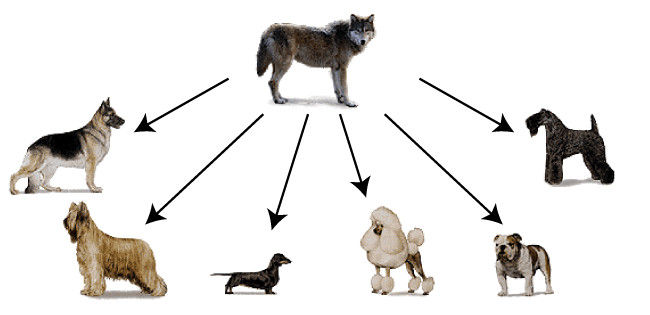
Note that the differences between dog breeds aren’t only about looks. It’s also about behavior. Breeds like Rottweilers and boxers were bred to be protective. Collies and sheepdogs were bred for herding. Retrievers retrieve. Spaniels are hunting dogs. These behaviors are innate (though training can improve and shape a dog’s behavior). Click here to read more about the genetic basis of dog behavior (the link opens in a new tab).
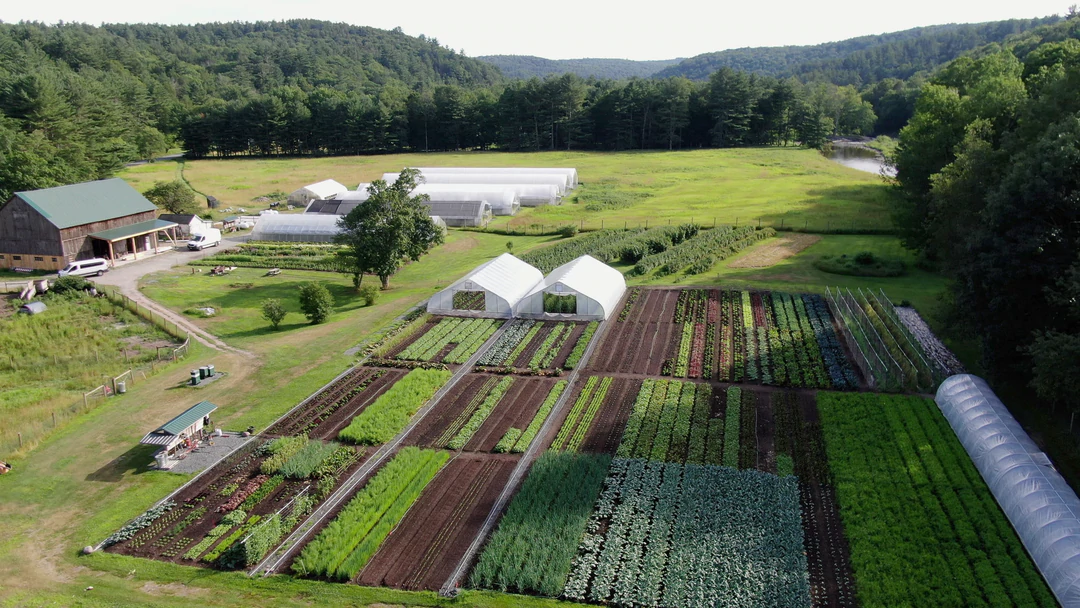
Note that the words we use for the results of selective breeding are different for animals and plants. The result of animal breeding is a breed. The results of plant breeding is a variety.
Selective breeding has produced hundreds of breeds of animals and varieties of plants with desired traits. If you visit a farm and look at the animals and plants that are being grown there, that’s pretty much all that you’ll see.
A term for “trait” used in biology is phenotype, which means any observable characteristic. So, another way to formulate what happens in selective breeding is that breeders create distinct phenotypes in controlled populations of organisms.
To contrast the process of selective breeding to what happens in nature, selective breeding is also called artificial selection. Before we examine what happens in nature — the adaptation-producing process of natural selection — complete the quiz below.
4. Selective Breeding Flashcards
[qdeck]
[h]Selective Breeding Flashcards
[q]Describe what happens in selective breeding.
[a]In selective breeding, breeders select organisms with a desired trait, and only allow those organisms to breed. Over time, they create a population of organisms that includes only those individuals with the desired trait.
[q]The terms we use for the results of selective breeding in animals and plants are different. What are these terms?
[a]The results of selective breeding in animals are called breeds. In plants, they’re called varieties.
[q]Selective breeding is also known as….
[a]Selective breeding is also known as artificial selection.
[q]Selective breeding requires that the animal or plant breeder select for the same phenotype for ______________ generations.
[a]Selective breeding requires that the animal or plant breeder select for the same phenotype for multiple generations.
[q]Terriers, poodles, labrador retrievers, and chihuahuas are all members of the same __________. Their differences were brought about through __________ breeding, also known as ________ selection.
[a]Terriers, poodles, labrador retrievers, and chihuahuas are all members of the same species. Their differences were brought about through selective breeding, also known as artificial selection.
[q]A word used in genetics for a physical or behavior trait is ______________.
[a]A word used in genetics for a physical or behavior trait is phenotype.
[/qdeck]
5. Adaptation and Selective Breeding: Checking Understanding
[qwiz]
[h]Adaptation and Selective Breeding Quiz
[i]Biohaiku
Selective breeding:
Humans choose traits they desire
Wolves became poodles
[q] A trait that can help an organism survive and/or reproduce is called a(n) [hangman]
[c]IGFkYXB0YXRpb24=[Qq]
[q] In the case of the leaf insect, the adaptation is for [hangman].
[c]IGNhbW91ZmxhZ2U=[Qq]
[q] For a trait to be adaptive, it must help an organism to [hangman] or to reproduce.
[c]IHN1cnZpdmU=[Qq]
[q] A leaf insect’s camouflage is only useful in a forest with many leaves. This is an example of the idea that the value of an adaptation is usually limited to a specific [hangman] .
[c]IGVudmlyb25tZW50[Qq]
[q multiple_choice=”true”] The moon’s mass and distance from the Earth are an adaptation for producing the ocean’s tides.
[c]IHRydWU=[Qq]
[f]IE5vLiBUaGUgbW9vbiBpcyBhIG5vbmxpdmluZyBvYmplY3QuIFdoaWxlIGl0cyBkaXN0YW5jZSBhbmQgbWFzcyBhcmUgbGFyZ2VseSByZXNwb25zaWJsZSBmb3LCoCB0aGUgb2NlYW4mIzgyMTc7cyB0aWRlcyAodGhlIHN1biBhbHNvIHBsYXlzIGEgcm9sZSksIHRob3NlIGFyZW4mIzgyMTc7dCBhZGFwdGF0aW9ucy4gVGhleSYjODIxNztyZSBzaW1wbHkgcGh5c2ljYWwgYXR0cmlidXRlcy4=[Qq]
[c]IGZh bHNl[Qq]
[f]IFRoYXQmIzgyMTc7cyBjb3JyZWN0LiBUaGUgbW9vbiBpcyBhbiBpbmFuaW1hdGUgb2JqZWN0LiBJdCBoYXMgY2hhcmFjdGVyaXN0aWNzLCBidXQgbm9uZSBvZiB0aGVtIGFyZSBhZGFwdGF0aW9ucyAod2hpY2ggYXJlIGxpbWl0ZWQgdG8gbGl2aW5nIHRoaW5ncyku[Qq]
[q]In domesticated plants and animals, humans produce desired traits through the process of [hangman] breeding
[c]c2VsZWN0aXZl[Qq]
[q]For selective breeding to work, a breeder must select (or breed for) the same trait for multiple [hangman]
[c]Z2VuZXJhdGlvbnM=[Qq]
[q]Terriers, poodles, labrador retrievers, and chihuahuas are all members of the same [hangman]. Their differences were brought about through [hangman] breeding, also known as [hangman] selection.
[c]c3BlY2llcw==[Qq]
[c]c2VsZWN0aXZl[Qq]
[c]YXJ0aWZpY2lhbA==[Qq]
[q]In animals like dogs, breeders have been able to create breeds with specific body forms and specific [hangman], such as protecting, retrieving, herding,
[c]YmVoYXZpb3Jz[Qq]
[q]A word used in genetics for a physical or behavioral trait or characteristic is [hangman].
[c]cGhlbm90eXBl[Qq]
[/qwiz]
4. What’s Next?
- Proceed to Natural Selection (the next HS-Level tutorial in this module)
- Return to Thinking Like Darwin (HS-Level) Main Menu
